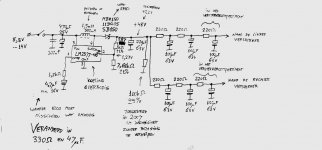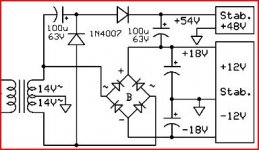My son has asked me to build for him a mic pre-amp.
I have read this on the subject.
http://www.thatcorp.com/datashts/AES129_Designing_Mic_Preamps.pdf
I have been simulating a circuit that I believe produces the right audio levels and has enough headroom to classify as "professional audio". I attach it here.
What I am now after is the phantom power generation and any issues that might be lurking. Has anyone got any suggestions?
I have read this on the subject.
http://www.thatcorp.com/datashts/AES129_Designing_Mic_Preamps.pdf
I have been simulating a circuit that I believe produces the right audio levels and has enough headroom to classify as "professional audio". I attach it here.
What I am now after is the phantom power generation and any issues that might be lurking. Has anyone got any suggestions?
Attachments
You could try a couple of these:
NMA2412SC Murata Power Solutions Inc | 811-1468-5-ND | DigiKey
Followed by one of these low drop out regulators:
PMIC - Voltage Regulators - Linear (LDO) | Integrated Circuits (ICs) | DigiKey
NMA2412SC Murata Power Solutions Inc | 811-1468-5-ND | DigiKey
Followed by one of these low drop out regulators:
PMIC - Voltage Regulators - Linear (LDO) | Integrated Circuits (ICs) | DigiKey
A 48V supply is not essential, 12V will power a microphone quite happily.
That depends on the microphone, but many indeed work fine with 12 V and reduced resistors.
Attached is the schematic of the 48 V phantom supply that I use for my homemade battery powered stereo microphone preamplifier. The upper RCRCRC filter supplies the left channel and the lower the right channel. To compensate for the resistance in the RCRCRC filter, I reduced the resistors between supply and pin 2 of the input/supply and pin 3 of the input to 5.49 kohm each.
The inductor I used is an inductor with ferrite all around it (closed magnetic circuit) that is actually intended for loudspeaker crossover filters. It is from the brand Intertechnik and is marked "5014 Körper 0134 L=1,5 mH R=0,250 ohm diameter=0,85". The resistor and electrolytic capacitor at the bottom left are 330 ohm and 47 uF, with the original values the current peak at start-up got too large.
One thing you may have to protect your circuit against, is latch-up of the input op-amps. If for whatever reason the phantom supply comes up or goes down very quickly, the op-amp inputs may temporarily be driven beyond their supplies. That might induce destructive latch-up. Although most ICs are designed not to go into latch-up easily, I would add some small Schottky clamping diodes (BAT85 or similar) just to be sure.
Attachments
Last edited:
Many thanks.
I have looked into it a bit more and the design depends on what you have available. For example if you have a transformer you may try a voltage doubler. In my case I have +/-12V DC supplies and the only reasonable ways to get 48V DC are (a) a charge pump/voltage quadrupler or (b) a DC DC flyback like the LM2577/LM2588 (the latter being expensive).
Looking on ebay there are some such DC-DC modules quite cheap so I have got 2 of them to try out.
I have looked into it a bit more and the design depends on what you have available. For example if you have a transformer you may try a voltage doubler. In my case I have +/-12V DC supplies and the only reasonable ways to get 48V DC are (a) a charge pump/voltage quadrupler or (b) a DC DC flyback like the LM2577/LM2588 (the latter being expensive).
Looking on ebay there are some such DC-DC modules quite cheap so I have got 2 of them to try out.
Here is a Power One linear supply on ebay that is already built. This is what I use in my mixer. Power One HB 48 0 5 A Open Frame Linear DC Power Supply 48V 0 5A | eBay
Ray
Ray
Here;s the same model even cheaper. http://www.ebay.com/itm/POWER-ONE-H...347?pt=LH_DefaultDomain_0&hash=item259cb066fb
Universal Preamp/ Mixer
48V Phantom Feed Supply for Microphones
perfect projects lots of more on that website
48V Phantom Feed Supply for Microphones
perfect projects lots of more on that website
- Status
- Not open for further replies.
- Home
- Amplifiers
- Power Supplies
- Microphone pre-amp phantom supply


